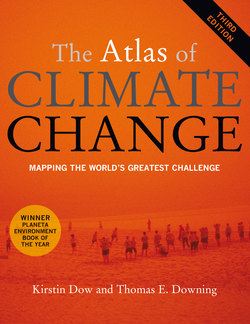Читать книгу The Atlas of Climate Change - Professor Kirstin Dow - Страница 6
На сайте Литреса книга снята с продажи.
Оглавление15 Agriculture 54 Agriculture is a major source of emissions, and vital for economic welfare in many countries. 16 The Carbon Balance 56 Changes in stored carbon are contributing to climate change. PART 4 EXPECTED CONSEQUENCES 59 17 Disrupted Ecosystems 60 Many species and ecosystems may not be able to adapt to new climatic conditions and stresses. 18 Water Security 62 Water scarcity has already become a major stress in some regions. Climate change may raise the stress level. 19 Food Security 64 Climate change threatens future agricultural development in some regions, and is benefiting others. 20 Threats to Health 66 The recent increase in the number of victims, and the economic costs of weather-related health effects may be a sign of the future. 21 Rising Sea Levels 68 Thermal expansion of oceans and melting ice will lead to a substantial rise in sea level, threatening many coastal communities. 22 Cities at Risk 70 The combined impact of changes in the climate is falling particularly hard on rapidly growing cities. 23 Cultural Losses 72 Climate change is threatening sites that represent the world’s cultural and historical heritage. PART 5 RESPONDING TO CHANGE 75 24 Urgent Action to Adapt 76 As climate change becomes more marked, the need for adaptation will be ever greater, and more difficult. 25 Building Capacity to Adapt 78 There is a need to develop effective strategies and actions, and to support efforts being made at all levels. 26 City Responses 80 Cities around the world are taking action to reduce their emissions. 27 Renewable Energy 82 Renewable energy sources could be the key to economically and socially sustainable societies. 28 Low Carbon Futures 84 Economic growth needs to be achieved with lower greenhouse gas emissions, especially in developing countries. 29 Counting Carbon 86 Accurate accounting of carbon and greenhouse gas emissions is essential.
